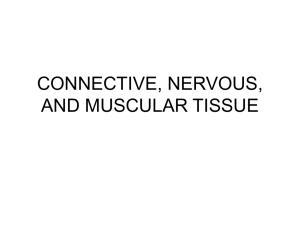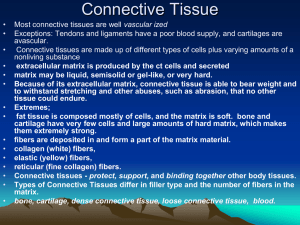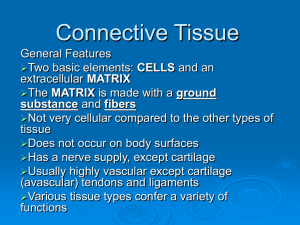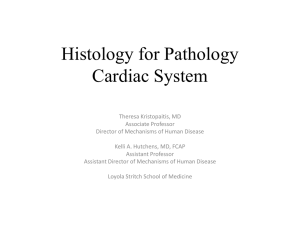Connective Tissues
advertisement
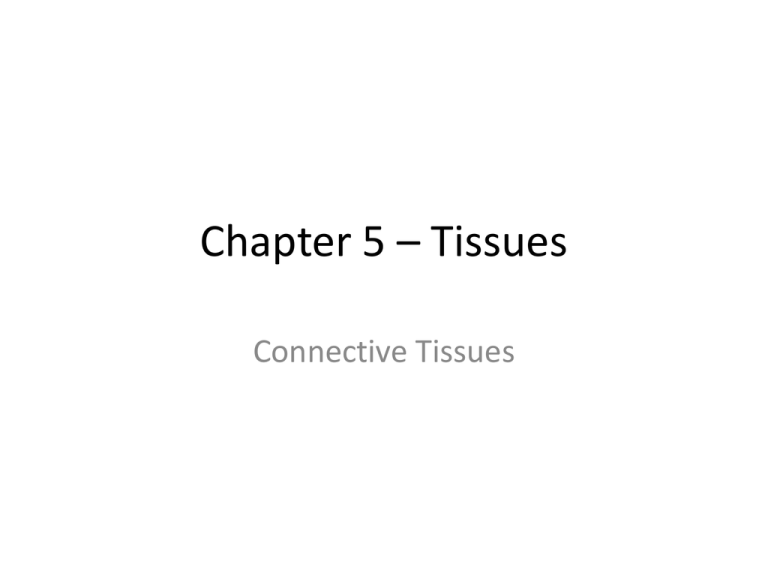
Chapter 5 – Tissues Connective Tissues General Characteristics of Connective Tissue • Most abundant type of tissue by weight. • Bind structures, provide support and protection, serve as frameworks, fill spaces, store fat, produce blood cells, protect against infections, and help repair tissue damage. • Can be rigid or flexible. • Usually have a good blood supply (for nutrients). General Structure of Connective Tissue • Cells are farther apart than cells in epithelial tissue • Have an abundance of extracellular matrix – Extracellular matrix consists of fibers and a ground substance that varies from fluid to solid • The ground substance binds, supports, and provides a medium through which substances can be transferred between blood and cells in the tissue Major Cell Types in Connective Tissue • Cells in connective tissue are divided into fixed cells and wandering cells. – Fixed cells are those that reside in the connective tissue for an extended period of time. – Wandering cells are those that move through and appear in connective tissue temporarily…usually in response to an injury or infection. Major Cell Types in Connective Tissue • Fixed cells include: – Fibroblasts • Most common kind of fixed cell in connective tissues • Large and star-shaped • Produce fibers by secreting proteins into the extracellular matrix – Mast cells • Usually located near blood vessels in connective tissues • Widely distributed • Release heparin (a compound that prevents blood clotting) and histamine (a substance that promotes reactions associated with inflammation and allergies) Fibroblast Mast Cell Major Cell Types in Connective Tissue • Wandering cells include: – Macrophages (or histiocytes) • Originate as white blood cells • Usually attached to fibers but can also detach and move about • Specialized for phagocytosis and so are important in immunity and defense against infection Macrophage Connective Tissue Fibers • 3 types of tissues are produced by fibroblasts: – Collagenous fibers – Elastic fibers – Reticular fibers (least abundant) Connective Tissue Fibers • Collagenous fibers – Composed of thick threads of the protein collagen (which is the major structural protein of the body) – Grouped in long, parallel bundles – Flexible but only slightly elastic – Have really good tensile strength (resistance to a pulling force) – Important component of body parts that hold structures together such as ligaments and tendons – Tissue with lots of collagenous fibers is termed dense connective tissue and appears white – Tissue with very few collagenous fibers is termed loose connective tissue Connective Tissue Fibers • Elastic Fibers – Composed of the spring-like protein elastin – Fibers branch and form complex networks – Fibers are weaker than collagenous fibers but are very elastic (easily retain their shape after being stretched and deformed) – Normally found in body parts that are stretched such as vocal cords and the air passages of the respiratory system – Sometimes called yellow fibers as this is the color of tissues that have lots of elastic fibers Collagenous and Elastic Fibers Connective Tissue Fibers • Reticular Fibers – Composed of very thin collagenous fibers – Highly branched – Form delicate supporting networks in tissues such as those of the spleen Categories of Connective Tissues • Connective tissue is divided into two categories: – Connective tissue proper • Includes loose connective tissue, adipose tissue, reticular connective tissue, dense connective tissue, and elastic connective tissue – Specialized connective tissue • Include cartilage, bone, and blood Connective Tissue Proper • Loose connective tissue (or areolar tissue) – Forms delicate thin membranes throughout the body – Cells are mainly fibroblasts and are spread far apart with a gel-like ground substance between them • The ground substance contains many collagenous and elastic fibers that are secreted by the fibroblasts – Binds the skin to underlying organs, fills spaces between muscles, and lies beneath most layers of epithelium (remember, connective tissue provides the nutrient source for epithelial tissue) Loose Connective Tissue Connective Tissue Proper • Adipose Tissue – Or…fat – Has cells called adipocytes that store fat in droplets within their cytoplasm • Every person is born with a certain number of adipocytes • At first these cells resemble fibroblasts • As the cells get bigger (through accumulation of fat) their nuclei get pushed to one side • When groups of these cell become so large that they crowd out other types of cells, adipose tissue is formed • If a person goes through a period if fasting, the cells may loose fat and shrink, resembling fibroblasts again – Lies beneath the skin (for insulation and energy storage), in spaces between muscles, around the kidneys and certain joints (for cushioning), behind the eyeballs, in certain abdominal membranes, and on the surface of the heart Adipose Tissue Connective Tissue Proper • Reticular Connective Tissue – Composed of thin, collagenous fibers in a 3-D network (called reticular fibers) – Help provide the framework for specific internal organs, such as the spleen, liver, and lymphatic organs Reticular Connective Tissue Connective Tissue Proper • Dense Connective Tissue – Composed of many closely packed, thick collagenous fibers, a fine network of elastic fibers and a few cells (which are mostly fibroblasts) – May be classified as regular or irregular depending on how the fibers are organized • Regular dense connective tissue has collagenous fibers that are very strong, which allows the tissue to withstand pulling forces – Abundant in tendons and ligaments – Blood supply is poor which slows the time for tissue repair (such as in a sprained joint) • Irregular dense connective tissue has fibers that are thicker, interwoven, and more randomly organized, allowing the tissue to sustain tension exerted from many different directions – Found in the dermis (inner layer of the skin) Dense Connective Tissue Connective Tissue Proper • Elastic Connective Tissue – Composed mainly of yellow, elastic fibers in parallel strands or in branching networks with collagenous fibers and fibroblasts in between – Found in the attachments between bones of the spinal column (ligamenta flava) and in layers within the walls of certain hollow internal organs (including the larger arteries), some portions of the heart, and the larger airways Elastic Connective Tissue Specialized Connective Tissue • Cartilage – Provides support, frameworks and attachments, protects underlying tissues, and forms structural models for many developing bones – Has abundant extracellular matrix composed largely of collagenous fibers embedded in a gel-like ground substance that is rich in a protein-polysaccharide complex (chondromucoprotein) and contains a large volume of water • Cartilage cells, called chondrocytes, occupy small chambers called lacunae that lie completely within this matrix – Because cartilage tissue lacks a direct blood supply, nutrients must be obtained through diffusion from the perichondrium, which is a covering of connective tissues that surround cartilagenous structure • This lack of direct nutrients causes low levels of cell division and longer healing times Specialized Connective Tissue • Cartilage – Cartilage can be divided into three types based on differences in the extracellular matrix • Hyaline cartilage – Has very fine collagenous fibers in the extracellular matrix – Most common type – Found on the ends of bones in many joints, in the soft part of the nose, and in the supporting rings of the respiratory passages – Important in the development and growth of most bones » Parts of an embryo’s skeleton actually begin as hyaline cartilage “models” that bone slowly replaces • Elastic cartilage – Has a dense network of elastic fibers in its extracellular matrix (making it flexible) – Provides the framework for the external ears and parts of the larynx • Fibrocartilage – Has many large collagenous fibers in its extracellular matrix (making it very tough) – Provides a “shock absorber” for structures that are subjected to pressure, such as vertebrae, knees, and the pelvic girdle. Hyaline Cartilage Elastic Cartilage Fibrocartilage Specialized Connective Tissue • Bone (osseous tissue) – Most rigid type of connective tissue • Due to mineral salts (such as calcium carbonate and calcium phosphate) and abundant flexible collagenous fibers being located between cells – Supports body structures internally, protects vital structures in the thoracic and cranial cavities, serves as an attachment for muscles, forms blood cells in red marrow, and stores and releases inorganic chemicals such as calcium and phosphorous Specialized Connective Tissue • Bone (osseous tissue) – Structure • Bone matrix forms thin layers called lamellae that are located in concentric patterns around capillaries that are located within tiny longitudinal tubes called central (Haversian) canals. – Each central canal contains a blood vessel, so each bone cell has a close supply of nutrients – In addition, each bone cell has many cytoplasmic processes that extend outward, pass through minute tubes in the extracellular matrix called canaliculi, and are attached by gap junctions to the membranes of nearby cells, leading to rapid movement of materials between blood vessels and bone cells and rapid healing. • Bone matrix is deposited by cells called osteoblasts (which mature into osteocytes) that are located in lacunae – Osteoblasts are evenly spaced within the lamellae and also form concentric circles • Together, the osteocytes, layers of extracellular matrix and the central canals around which they are clustered form a cylindrical shaped unit called an osteon, or Haversian system – Many of these units become cemented together to form the substance of bone Bone Tissue Specialized Connective Tissue • Blood – Composed of cells suspended in a fluid extracellular matrix called plasma – Most blood cells form in special tissues called hematopoietic tissues in the red marrow that is located in the hollow part of certain bones – Types of blood cells • Red blood cells – Transport gases – Function completely within the blood vessels • White blood cells – Fight infection – Typically migrate from the blood through capillary walls to connective tissues where they carry out their major activities and usually remain until they die • Platelets – Involved in blood clotting Blood Tissue




